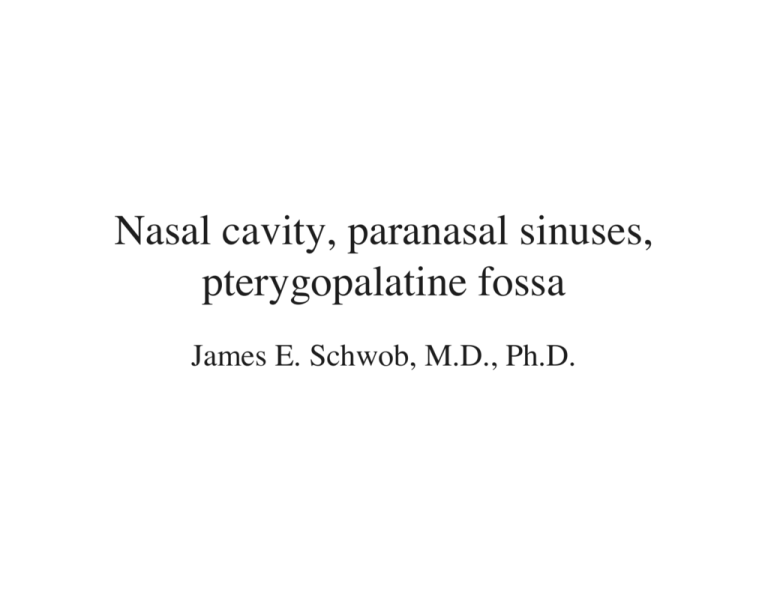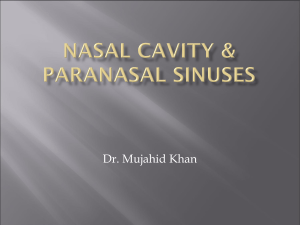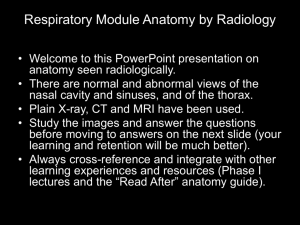nasal cavity etc b&w
advertisement

Nasal cavity, paranasal sinuses, pterygopalatine fossa James E. Schwob, M.D., Ph.D. What are noses good for? • Aesthetics • Respiratory function (protective) • Sensory function And you can clone from them! Although their identity remains controversial … Broadly potent neurocompetent stem cells are found in olfactory mucosa • Recent work from Mackay-Sim has demonstrated that OE cells (including human) can generate many non-olfactory types after transplantation. Clinical significance • Well over $2 billion spent on nasal nostrums per year for treating colds, sinusitis • Loss of olfactory sensory function can be life-threatening, and is certainly a quality of life issue What do we mean by the nose and paranasal sinuses • External nose and internal nose (nasal cavity) • Both have bony and cartilaginous parts • Both are richly innervated and vascularized • Paranasal sinuses flank the nasal cavity • Pterygopalatine ganglion and fossa are intimately involved with both “Surface” anatomy of the nasal cavity • Boundaries: roof, walls, floor, inlet, outlet • Recesses: 4 passages defined by nasal conchae • Ostia: only sphenoid is visible Recesses along lateral wall • Removal of middle and inferior nasal conchae reveals numerous ostia Bony skeleton • External nose: bones and cartilage Bony skeleton II • Medial wall: nasal septum Bony skeleton III • Lateral wall: with and without conchae • Note openings into sinus and pterygopalatine fossa Bony skeleton IV • Pterygopalatine fossa is entryway into nasal cavity for nerves and vessels Vasculature of nasal cavity I • Maxillary artery (3rd part) enters via the pterygopalatine fossa and supplies posterior half of nasal cavity and maxillary sinus Vasculature II • Branches from maxillary artery to posterior-ventral half of medial and lateral walls • From ophthalmic to anterior-dorsal • From facial to vestibule • Epistaxis (no picking and grinning) Innervation of the nasal cavity and paranasal sinuses • General sensory from Trigeminal (CN V) – Ophthalmic division (V1) – Maxillary division (V2) Innervation II • Autonomics: – Preganglionic parasympathetic via greater petrosal branch of facial nerve to pterygopalatine ganglion. Postganglionics distribute with branches of maxillary nerve – Postganglionic sympathetics via the carotid plexus and deep petrosal nerve Innervation III V IX X VII • Special sensory: – Olfactory -- CN I – Taste -- via greater petrosal to palatine Paranasal sinuses • What are they? • What are they good for? Three views Imaging the sinuses Maxillary sinus drainage Surgical approach to maxillary sinusitis Imaging the sinuses The trouble with sphenoids • Many important structures are near the sphenoid and vulnerable • Including the optic nerve Paranasal sinuses are late to grow “Surface” anatomy of the nasal cavity • Boundaries: roof, walls, floor, inlet, outlet • Recesses: 4 passages defined by nasal conchae • Ostia: only sphenoid is visible Endoscopic tour of the nasal cavity What can go wrong and how to fix it “Surface” anatomy of the nasal cavity • Boundaries: roof, walls, floor, inlet, outlet • Recesses: 4 passages defined by nasal conchae • Ostia: only sphenoid is visible











